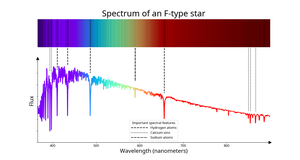Glossarbegriffe: F-Stern
Description: Ein F-Stern gehört der Spektralklasse "F" an. Astronomen erkennen F-Sterne an ihren mäßig stark ionisierten Kalziumlinien und einigen anderen atomaren Metalllinien sowie an den schwachen Wasserstoff-Absorptionslinien in ihren Spektren. Sie haben typische (effektive) Temperaturen zwischen 6000 Kelvin (K) und 7400 K. Im Vergleich zu anderen Sternen erscheinen sie dem menschlichen Auge weiß oder gelblich-weiß, es sei denn, die interstellare oder atmosphärische Extinktion spielt eine Rolle. Ein Beispiel für einen F-Stern ist der Polarstern (Polaris) im Sternbild Kleiner Bär.
Zugehörige Glossarbegriffe:
See this term in other languages
Term and definition status: The original definition of this term in English have been approved by a research astronomer and a teacher The translation of this term and its definition is still awaiting approval
The OAE Multilingual Glossary is a project of the IAU Office of Astronomy for Education (OAE) in collaboration with the IAU Office of Astronomy Outreach (OAO). The terms and definitions were chosen, written and reviewed by a collective effort from the OAE, the OAE Centers and Nodes, the OAE National Astronomy Education Coordinators (NAECs) and other volunteers. You can find a full list of credits here. All glossary terms and their definitions are released under a Creative Commons CC BY-4.0 license and should be credited to "IAU OAE".
Related Diagrams
Spectrum of an F-type star
Bildnachweis: IAU OAE/SDSS/Niall Deacon
License: CC-BY-4.0 Creative Commons Namensnennung 4.0 International (CC BY 4.0) icons









